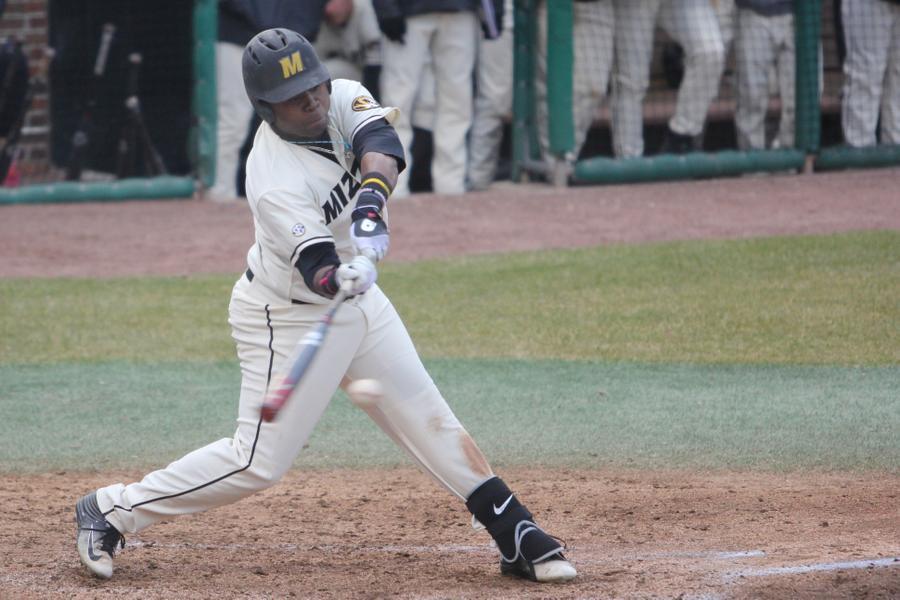
It’s the hallmark of any good baseball lineup. It’s Todd Frazier for Jose Abreu with the Chicago White Sox. It was Matt Holliday for Jason Heyward — sorry… too soon? Regardless, protection for a team’s top hitters is critical. It opens up limitless possibilities for having a fluid lineup and allows the top hitters to simply worry about getting on base instead of putting pressure on them to be big RBI guys. That’s exactly what junior center fielder Jake Ring has meant for junior shortstop Ryan Howard this season.
Howard, who initially began the 2016 campaign as Missouri’s leadoff hitter, slipped to second in the order 10 games ago and has excelled in his new role. Coach Tim Jamieson said that he had confidence in Howard as a leadoff hitter, but decided it was time for a change.
“We didn’t like to use Howard at leadoff because it just didn’t feel right,” Jamieson said.
The thinking was to have Howard, who Jamieson described before the season as the team’s best all-around hitter, bat first and set the tone early. However, after the Tigers averaged just four runs per game over a four-game series with Seton Hall to begin the year, Jamieson had seen enough. With the emergence of freshman right fielder Connor Brumfield, it allowed everyone in the order to drop down a slot. Howard became the No. 2 hitter and Ring found a home in the third spot.
“I think what’s been really good is to have guys that get on base ahead of both Ryan and Jake,” Jamieson said. “Connor’s emergence has really helped everybody.”
Sandwiched between Ring, who is hitting at a .358 clip behind Howard, and Brumfield, who is batting .313, Howard has excelled in the early going. With the two threats on either side of him, pitchers have been more inclined to roll the dice and pitch to Howard instead of putting him on base with a free pass.
“If (Brumfield’s) getting on base ahead of your best hitters, it’s a lot easier to score runs,” Jamieson said.
Moreover, pitchers — though they might not be willing to admit it — have a tendency to look ahead. They’re constantly looking at who the man in the on-deck circle is, which only adds to the likelihood of making a mistake with the batter they should be worried about — the one at the plate. In this case, with pitchers consistently peering over to see Ring in the on deck circle, it should give Howard more of an opportunity to sit on a fastball or take advantage of a hanging breaking ball. Being a lefty, Ring’s impact as protection for Howard increases tenfold.
In his new role as the No. 2 hitter, Howard has reached base in all 10 games and has recorded four multi-hit efforts. He’s also smacked a pair of home runs since the change and knocked in eight RBIs.
The bottom third of the order has also reaped the benefits of the new-look lineup. With guys getting on ahead of them more often, the bottom three aren’t forced to be big run manufacturers. Instead, they can focus more on a small-ball type approach — moving runners over via sacrifice bunts and hits, working deep counts, etc. Since Howard’s move down, the various combinations of 6–9 hitters have combined to hit .384 with 22 RBIs and 23 runs. That’s a monumental boost in production from a source that wasn’t expected to give much this season.
“If we get to the point where we have multiple guys contributing, it makes a big difference,” Jamieson said.
Senior first baseman Zach Lavy relayed Jamieson’s message.
“When you see teams scoring a lot of runs, the big innings seem to come when the lower guys get on base,” Lavy said.
As the Tigers get ready for the start of SEC play — a mere week and a half away — it will be interesting to see if the momentum gathered over the past 10 games with this new lineup can continue. Jamieson seems comfortable with the 1–9 he’s got locked in right now, but as we’ve seen already this season, it’s always subject to change.
_Edited by Alec Lewis | [email protected]_